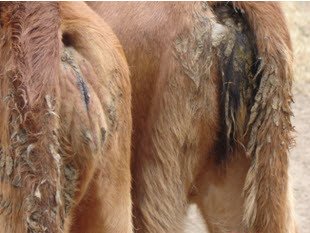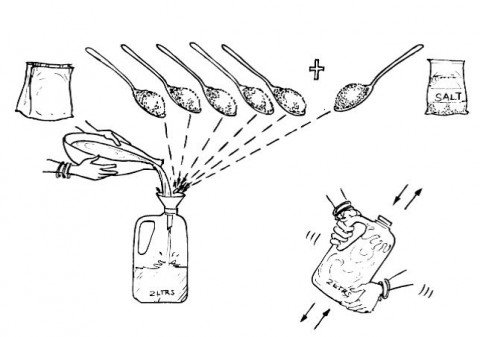Calf white scours / diarrhoea (calf enteritis)
Common names: Calf enteritis, Calf diarrhoea
Description: Management disease
Description: Management disease
Calf diarrhoea also called ‘white scours’ is a disease caused by bacteria present in the intestinal tract. It is very common in suckling calves during their first weeks after birth.
Calf diarrhoea is encouraged by late feeding of colostrum to the newborn calf, overcrowding of calves in pens, dirty environment and damp housing, poor hygiene in general and bad feeding practice particularly abrupt overfeeding with milk. (Colostrum is the first milk produced by the cow after delivery, the calf has to drink it within the first few hours until 24 hours of its life).
|
 |
Signs of Calf white scours
- Bad smelling diarrhoea which is usually whitish in colour and sometimes frothy. In older calves, the colour of the dung is darker.
- The affected calves lack appetite, are dull and listless.
- The calf develops fever and is reluctant to stand up
- As the diarrhoea progresses the calf becomes very dull, has a cold nose, the eyes retreat into their sockets and the skin feels cold and un-elastic (skin fold when raised does not slide back), it can no longer stand without support – these are clear signs of dehydration (the calf’s body drying out). Most calves that reach an advanced stage of dehydration will not survive, no matter how you treat.
Treatment of calf diarrhoea in suckling calves
Small calves with diarrhoea lose a lot of fluid, minerals and energy very fast because they pass a lot of watery faeces and at the same time stop drinking, because they have fever. They do not die from a specific infection but they die because their bodies dry out (=dehydration ) and they become extremely weak. Older animals with larger bodies have much more fluid, minerals and energy reserves and can withstand diarrhoea for a much longer time.
The most important treatment, irrespective of the cause of the diarrhoea, is to immediately replace the fluid-minerals-and-energy loss. This is called rehydration.
Rehydration
Instruction how to give oral rehydration fluid:
- Mix 5 tablespoons of sugar and 1 tablespoon of salt with 2 litres of clean water (boil water and let it cool down before mixing). Instead of 5 tablespoons sugar it is also very good to use 5 tablespoons of honey. A calf of 30 kg needs minimum 3 litres per day (minimum 1 litre for 10 kg of body weight per day). Feed the rehydration fluid in small portions at the rate of one and a half cup full at a time (equal to about 0.5litre).

(c) Dr Mario Younan for Biovision
- In addition finely crushed charcoal powder can be added to the rehydration fluid (2 handful of charcoal powder per litre, then passed through a sieve before giving it to the calf).
- It is very important to start giving rehydration fluid early, when the calf is still able to stand and suck actively
- Rehydration fluid should be given until the calf is drinking normally again and faeces are no longer watery (3-5 days).
- It is good to stop giving milk (severe cases) or to reduce the amount of milk on the first day; the milk may be withheld for 24 hours but not for longer than 36 hours. So from the second day on you can start giving small amounts of milk while still feeding rehydration fluid
- Giving sulphonamide drugs (sachets with powder) by mouth helps the calf to overcome infection in the intestine, butsulphonamide or antibiotic alone without rehydration will not save a calf with severe diarrhoea
Prevention and Control
- Assist the calf to drink colostrum as early as possible after birth, colostrum is a free oral vaccination against diarrhoea
- Good hygiene in the calf house is very important control measure to prevent calves from infecting each other
- Good hygiene also includes separation of the sick calves from the rest of the calves.
- Provision of warm dry beddings and regular feeding regime
To read more on calf care click here: A calf life worth living
